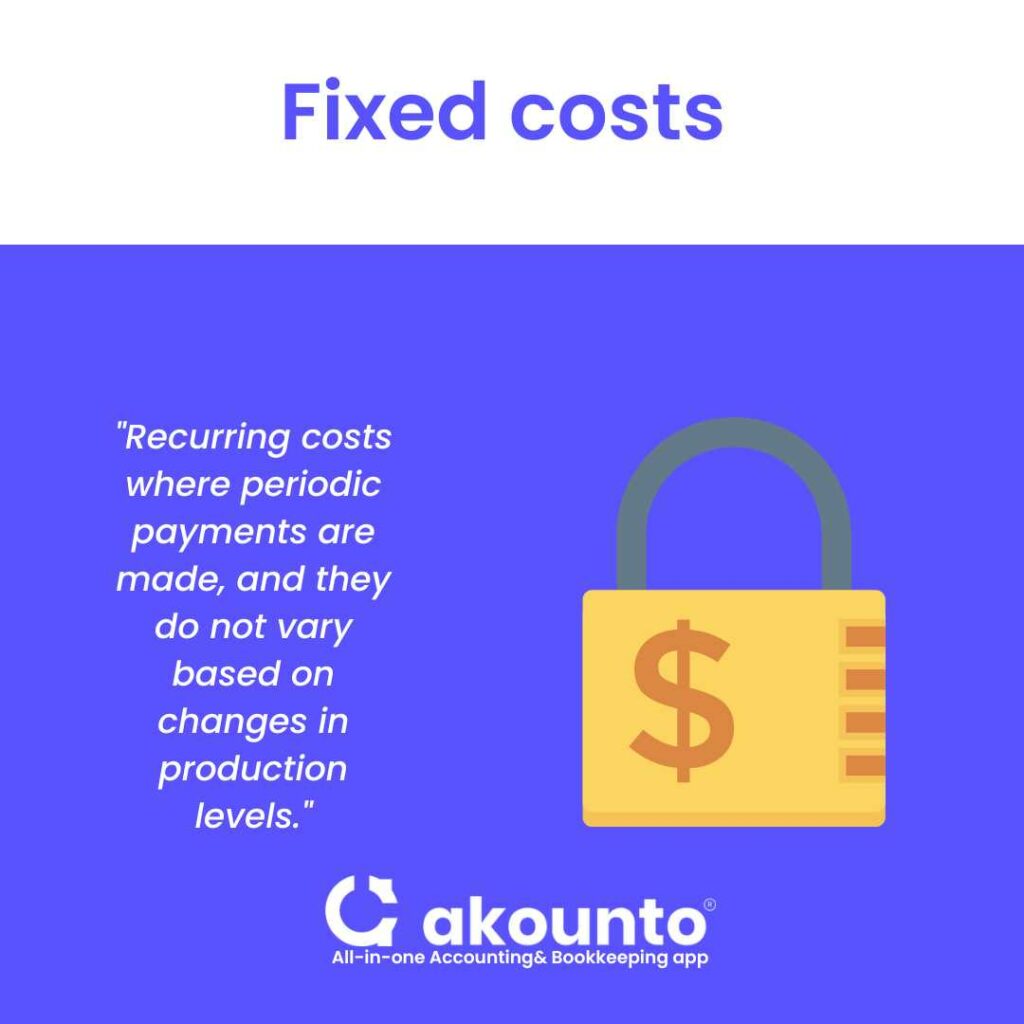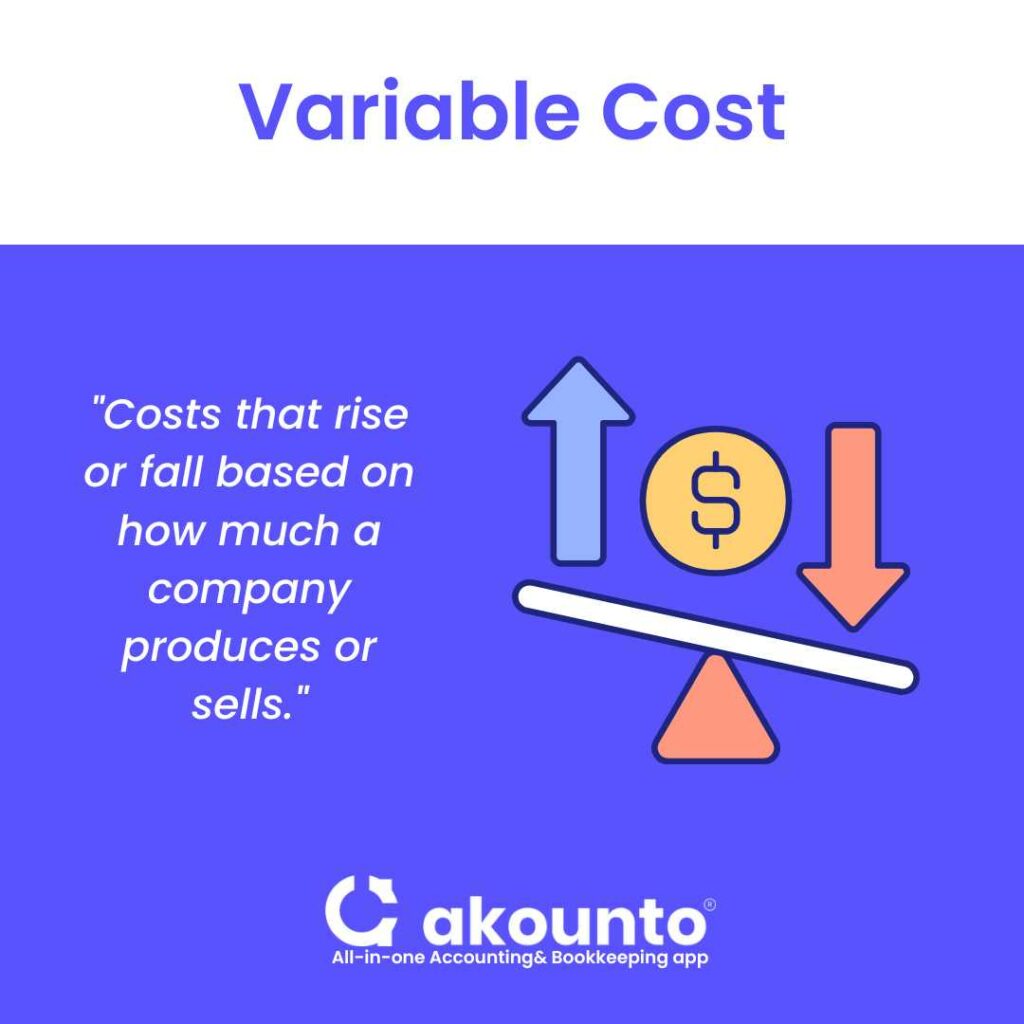Fixed costs are recurring expenses that remain constant irrespective of the business’s activity level.
Fixed costs are not tied to any business process or activity like production, manufacturing, sales, rendering services, etc. Fixed costs are prevalent in any given business, whether a service or manufacturing company.

Fixed cost examples include (not exhaustive list):
- Property tax
- Monthly rent
- Health insurance premiums
- Depreciation
- Lease
- Utility bills like electricity, gas, etc.
- Server costs
- Mortgage payments
Fixed costs are often recurring costs where periodic payments are to be made and are not varied to the changes in the production levels.
Fixed costs remain an important consideration for making financial decisions. When a business is in losses or is dormant, even then, fixed costs will be charged as a business expense which will severely impact the balance sheet of the company.
Even in normal business operations, the fixed cost as a component of the total cost is important for decision-making because it blocks a major part of the fund and cannot be deployed for revenue generation directly.
Fixed cost is a predictable cost. Therefore, businesses must plan, budget, and optimize fixed costs to achieve financial stability and keep the cost per unit low for higher profit margins.
Fixed Cost Formula
Calculating fixed costs involves adding up all the costs considered fixed, which can be generally located in the income statement and in the case of manufacturing companies; additionally, the trading account can also be referred to.
Fixed Cost = Total Cost – (Total Variable Cost per unit * Number of Units Produced)
The above-fixed cost formula can also be written as:
Fixed Cost = Total Cost – Total Variable Cost
Average Fixed Cost
The following formula, the fixed cost can also be calculated on a per unit basis, which is also called “average fixed cost”:
Fixed Cost (per unit) = Total Fixed Cost/ Number of Units Produced
Fixed Cost Ratio
The fixed cost ratio measures the proportion of fixed costs as a part of total costs, usually expressed in percentages.
Formula
Fixed Cost Ratio = Total Fixed Cost/ Total Cost
Fixed costs cannot be reduced in the short term, so the fixed cost ratio helps businesses to make budgeting decisions effectively.
High fixed costs mean that the company’s production has to generate higher revenues to break even, while low fixed costs mean that the variable cost per unit is higher, and the company earns a profit when sales are low.
Numerical Examples of Fixed Costs
Example 1: Company A is a watch manufacturing company. The production manager has reported the following figures for March:
Total watches made: 15,000 Units
The total cost incurred: $ 125,000
Variable cost per unit: $6
Calculate the fixed cost.
Solution:
Applying the formula:
Fixed Cost = Total Cost – (Total Variable Cost per unit * Number of Units Produced)
Fixed Cost = 125,000 – (6 * 15,000)
Fixed Cost = $ 35,000
Example 2: Company B is a phone manufacturing company. The production manager has reported the following figures for March:
Total Cost: 140,000
Units manufactured: 1300
Cost of raw material: $ 10 per unit
Labor charges: $ 40 per hour
Time taken to manufacture a single unit: 30 minutes per phone
Calculate the fixed cost as a whole and the fixed cost per unit.
Solution:
Formula
Fixed Cost = Total Cost – (Total Variable Cost per unit * Number of Units Produced)
Variable cost per unit = Raw material cost + labor cost = 10 + (40 * .50) = $ 30 per unit
Fixed Cost = 140,000 – (30 * 1300) = 1,40,000 – 39,000
Fixed Cost = $ 101,000
Fixed Cost per unit = 101,000/ 1300 = $ 77.69
Variable Cost

Variable costs change with the change in the production volume and sales increase. With increased production, the variable cost increases and vice versa.
Variable costs are most often part of direct costs.
Variable costs example:
- Direct labor costs like wages for hours worked
- Delivery and shipping costs
- Freight out
- Sales commissions
- Energy costs directly linked to the manufacturing process
Variable costs help determine the sales price as it is directly related to the production volume. With the change in the production levels, the variable costs generally rise, as a whole and per unit basis.
Variable cost is important in cost recovery and profit margin decisions.
Total Cost
Total cost includes both total fixed costs and variable costs that are incurred in producing a product or providing a service. Total costs comprise fixed and variable costs, direct and indirect costs, overhead costs, etc.
Total Cost Formula
Total Cost = Total Fixed Cost + Total Variable Cost
In cost accounting, the total cost per unit produced is an important financial metric that helps determine a long-term strategy, and production levels, control cost centers, and manage the overall cost of production and is an important managerial accounting metric useful in budgeting.
The total cost of production as a metric can be taken as a whole and expressed in terms of the cost per unit by dividing the total cost with the number of units produced or services provided.
Total Cost Per Unit Formula
Total Cost Per Unit = (Total Fixed Costs + Total Variable Costs)/ Total Number of Units Produced
Fixed Cost Vs. Variable Cost
Understanding the differences between fixed and variable costs is crucial for effective financial management and decision-making in a business. However, part of total costs helps determine different aspects of product-related decision-making.
| Fixed Cost | Variable Cost |
| Remains constant regardless of changes in production or sales | Changes with changes in production or sales |
| Examples include rent, salaries, insurance, and property taxes | Examples include raw materials, wages for production workers, and shipping costs |
| Cannot be reduced in the short term | Can be reduced by adjusting production levels or negotiating with suppliers |
| Used in break-even analysis to determine the point at which a business will cover all its costs and start making a profit | Used to calculate the total cost per unit of production |
| Important in budgeting, financial planning, and decision-making | Key factor in determining product pricing and production levels |
Fixed costs expenses do not change with changes in production or sales, while variable costs are expenses that increase or decrease with changes in production or sales.
Variable and fixed costs form important metrics in cost accounting, where the interplay between the two are the main determinant of the pricing policy and cost control.
Operating Leverage due to Fixed Cost
The relationship between fixed and variable costs leads to operating leverage. Cost structure management depends upon the proportion of fixed cost in the total cost.
A high proportion of fixed cost leads to higher operating leverage, while a low proportion leads to low operating leverage.
High operating leverage means more revenue is generated and is directly related to EBIT (operating income) and net profit.
Low operating leverage means that if the customer demand falls, the business generally has limited options for cost-cutting as the fixed cost component is low in its entire cost structure, thereby impacting its adaptability.
Breakeven Analysis
Breakeven analysis helps determine the production levels at a price point where there is no profit or no-loss situation. The revenue becomes equal to the cost.
Break-even analysis helps to determine a break-even point, where the minimum volume of goods and services a business sells to recover all its costs.
The break-even point is computed by dividing the total fixed costs by the net difference between the selling price per unit and the variable cost per unit.
Break-even point = Total Fixed Costs/ (Selling price per unit – variable cost per unit)
The break-even analysis determines the financial viability of a production project. Though it is a part of cost accounting, also an important tool in managerial accounting as it contributes to decision-making metrics of investing, capital budgeting, market analysis, production planning, etc.
On determining the break-even point, the business can form various strategies related to:
- Production strategy
- Distribution strategy
- Market segmentation and positioning
- Marketing, advertisement, and sales strategy
- Determining sales commissions
- Sales targets
Break-even analysis is a powerful business tool for planning and cost-effectively executing operational activities.
Marginal Costing
Marginal costing is a method in cost accounting where the additional cost of each unit of goods and services produced is calculated based on variable costs.
In marginal costing, fixed and variable costs help understand the cost of producing each unit and help businesses make informed decisions regarding pricing and production levels. Fixed cost is treated as a period cost that will be expended in the period in which they are incurred.
By focusing on the variable costs, businesses can determine the minimum price that must be charged for each unit to break even and achieve profitability. Companies often use it to gain a competitive advantage by reducing costs and improving profitability.
Uses of Fixed Cost
Understanding fixed costs and their importance to a company’s financial management is essential for business success. Fixed costs are significant for several reasons:
- Pricing Strategy: Both fixed costs and variable charges forms the components of the total cost of producing goods or services.
- Risk Management: As fixed costs are predictable and periodic in nature, thus any anticipated business shocks related to customer demand or liquidity crisis can be managed in advance.
- Production Planning: Fixed cost component cannot be zeroed and remains stable irrespective of output level. Thus it is the fixed part of the total cost of production which can be controlled and helpful in tackling volatility due to changes in variable costs.
- Cost Control: By managing fixed costs, businesses can mitigate against over-budgeting.
- Investment Decisions: Potential ROI for a project or product can be easily predicted, providing crucial input for capital budgeting decisions and calculating IRR (Internal Rate of Return), thereby minimizing capital costs.
Fixed Cost for Small Businesses
Fixed costs are major cost components of a new business, as they heavily invest in building capabilities and acquiring basic assets like office space, furniture, etc. Some overhead costs, like property taxes, advertisement expenses, etc., also inflate the fixed costs.
Most businesses have to deal with higher fixed costs in their early stages. The fixed cost may or may not contribute directly to the operating revenue generation activities but will periodically charge the company and deplete its cash flows. Preparing and anticipating fixed costs is beneficial in planning for the long run.
The only advantage is predictability and long-term optimization, which can be achieved by due diligence and planning.
A company must carefully manage its fixed costs to ensure its financial stability and profitability.
- Some strategies for managing fixed costs are:
- Choose between leasing and financing
- Negotiating better terms for rent
- Diligently finding loan sources that charge less interests
- Co-working, office-sharing, home-based, or going virtual
Final Words
Fixed costs are important for startups and small businesses in budgeting decisions and managing long-term profitability.
Visit Akounto’s Blog for scholarly articles that are helpful to business owners in running their business operations profitably.




